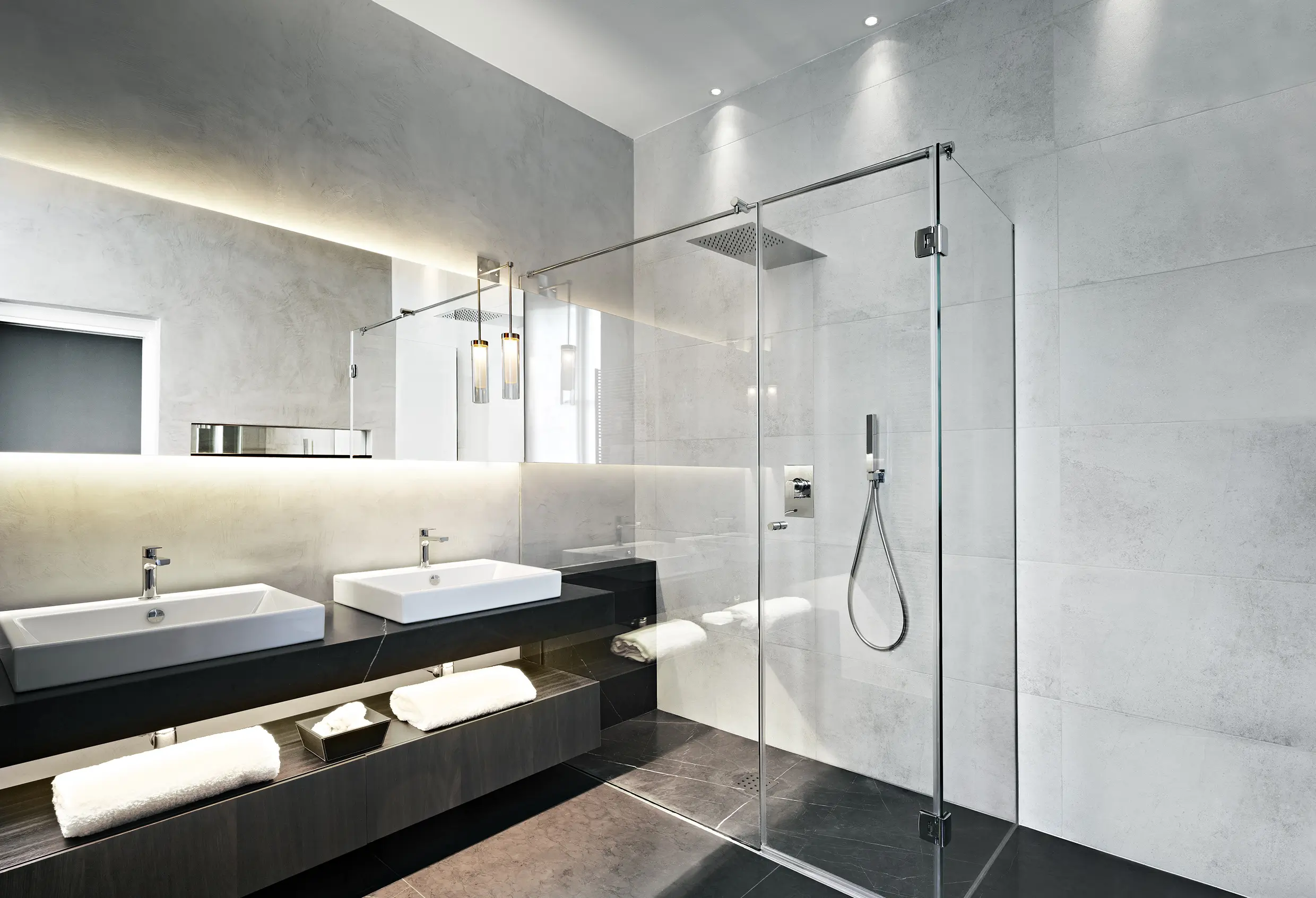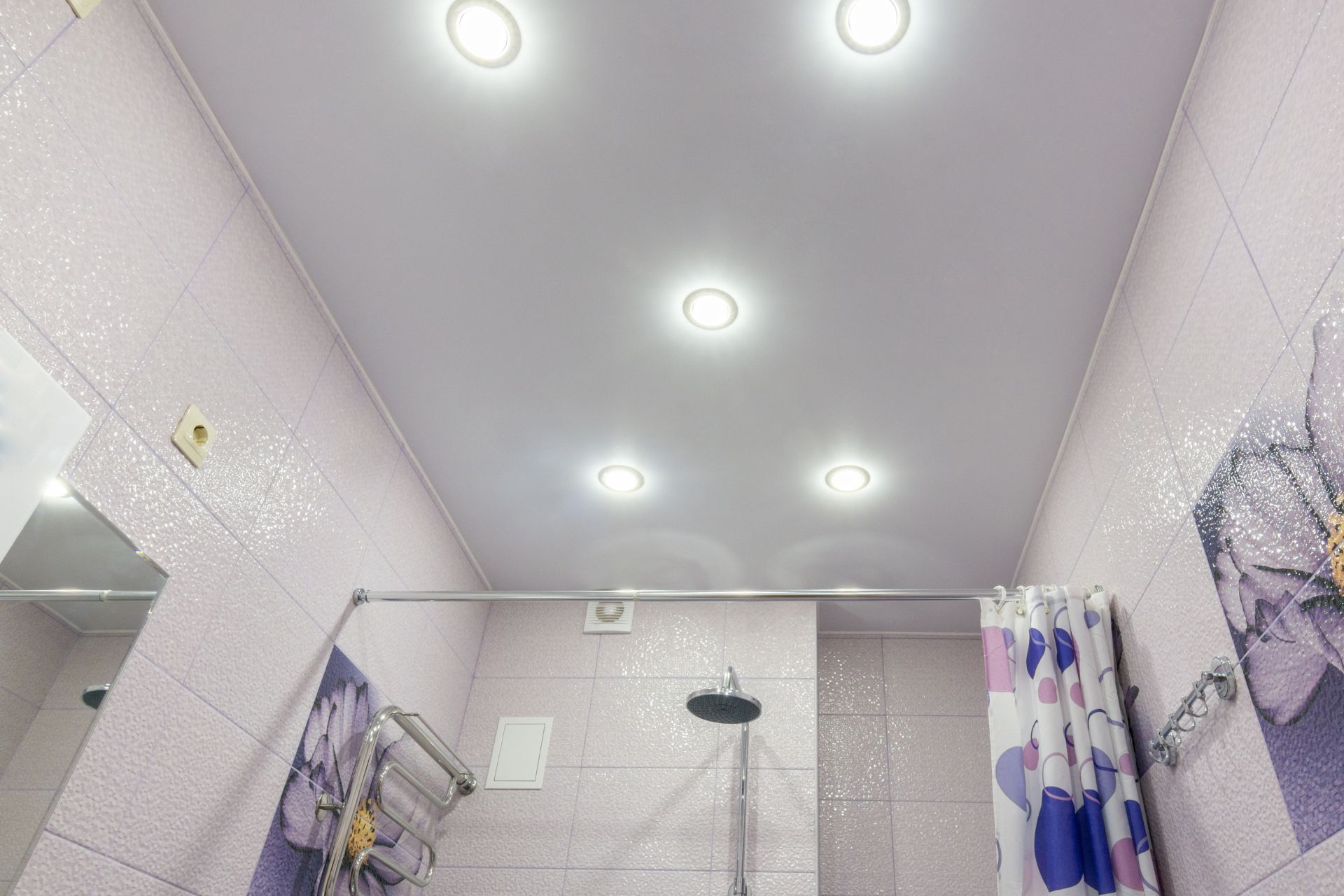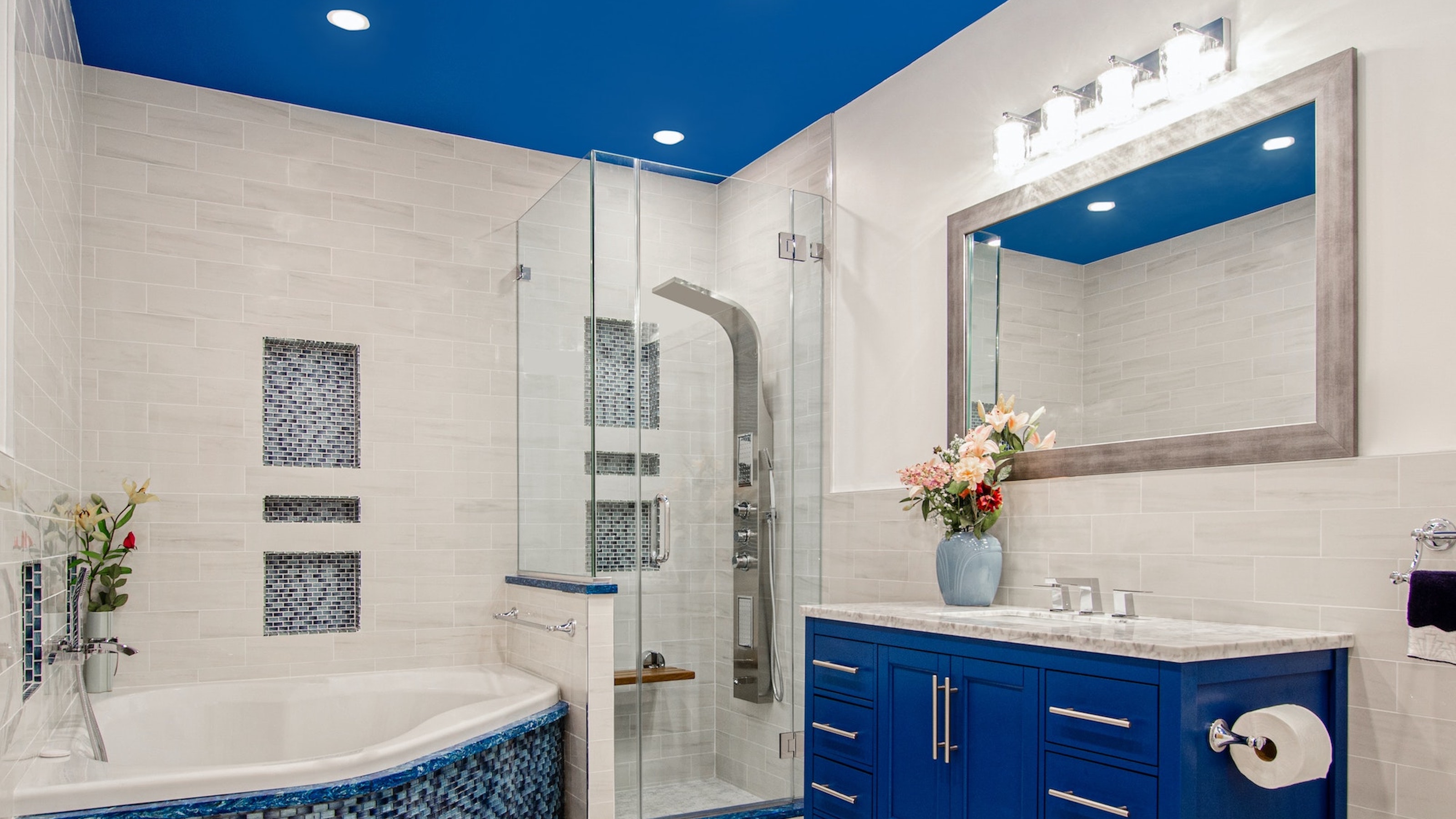Types of Bathroom Lighting

Bathroom lighting plays a crucial role in creating a functional and aesthetically pleasing space. Choosing the right type of lighting can enhance your bathroom’s ambiance, improve visibility for grooming tasks, and even highlight architectural features. Let’s explore the various types of bathroom lighting options available.
Recessed Lighting
Recessed lighting, also known as can lights, is a popular choice for bathrooms due to its sleek and unobtrusive design. These lights are installed flush with the ceiling, creating a clean and minimalist aesthetic.
Recessed lighting offers several advantages:
- Even Illumination: Recessed lights provide a uniform and even distribution of light, eliminating shadows and creating a well-lit space.
- Energy Efficiency: Many recessed lights use LED bulbs, which are known for their energy efficiency and long lifespan.
- Versatility: Recessed lights can be used to create different lighting effects, such as accent lighting or general illumination.
However, there are some drawbacks to consider:
- Installation Complexity: Installing recessed lighting can be more complex and time-consuming than other types of lighting, requiring professional assistance in most cases.
- Limited Dimming Options: Some recessed lights may not be compatible with dimmer switches, limiting your control over the brightness level.
Recessed lighting is ideal for general illumination in larger bathrooms, providing a bright and evenly lit space. However, it may not be suitable for areas requiring specific task lighting, such as the vanity or shower.
Pendant Lights, Overhead bathroom lighting ideas
Pendant lights are suspended fixtures that hang from the ceiling. They offer a unique and stylish way to illuminate a bathroom.
Pendant lights offer the following benefits:
- Design Flexibility: Pendant lights come in various shapes, sizes, and styles, allowing you to choose a fixture that complements your bathroom’s design.
- Statement Piece: Pendant lights can serve as a focal point in the bathroom, adding a touch of elegance and sophistication.
- Adjustable Height: Most pendant lights allow you to adjust their height, providing flexibility in positioning and light distribution.
However, there are some drawbacks to consider:
- Space Constraints: Pendant lights may not be suitable for bathrooms with low ceilings, as they can take up valuable space.
- Potential for Obstruction: The hanging fixture could obstruct movement or access to other bathroom fixtures.
Pendant lights are best suited for adding a decorative touch to a bathroom and providing focused lighting over specific areas, such as the bathtub or vanity.
Vanity Lights
Vanity lights are fixtures specifically designed for illuminating the bathroom vanity area. These lights are typically mounted on the wall above the mirror, providing focused light for grooming tasks.
Vanity lights offer several advantages:
- Improved Visibility: Vanity lights provide bright and focused light, allowing you to see your reflection clearly for applying makeup, shaving, or brushing your teeth.
- Variety of Styles: Vanity lights come in various styles, from traditional to modern, allowing you to choose a fixture that complements your bathroom’s design.
- Energy Efficiency: Many vanity lights use LED bulbs, which are energy-efficient and have a long lifespan.
However, there are some drawbacks to consider:
- Limited Illumination: Vanity lights primarily illuminate the vanity area and may not provide sufficient general lighting for the entire bathroom.
- Glare: If not positioned correctly, vanity lights can cause glare in the mirror, making it difficult to see clearly.
Vanity lights are essential for providing adequate illumination for grooming tasks at the vanity. They are best used in conjunction with other types of lighting to provide overall bathroom illumination.
Ambient Lighting
Ambient lighting provides general illumination for a bathroom, creating a relaxing and inviting atmosphere. This type of lighting is typically softer and more diffused than task lighting.
Ambient lighting offers the following benefits:
- Mood Setting: Ambient lighting can create a warm and inviting atmosphere, making the bathroom feel more relaxing and comfortable.
- Versatility: Ambient lighting can be achieved using various sources, such as sconces, chandeliers, or even string lights.
However, there are some drawbacks to consider:
- Insufficient Task Lighting: Ambient lighting alone may not provide enough brightness for tasks such as grooming or showering.
Ambient lighting is best used in conjunction with other types of lighting to create a balanced and functional bathroom space. It is ideal for creating a relaxing atmosphere, but it may not be sufficient for all bathroom activities.
Lighting Styles for Different Bathroom Aesthetics

A bathroom’s lighting scheme can significantly impact its overall ambiance and functionality. Different lighting styles can complement various bathroom aesthetics, enhancing the space’s mood and character. This section explores how different lighting styles can enhance specific bathroom aesthetics.
Modern Bathroom Lighting
Modern bathroom lighting prioritizes clean lines, minimalist designs, and a focus on functionality. Modern fixtures often feature geometric shapes, sleek materials like chrome or brushed nickel, and integrated LED technology. Modern lighting styles aim to create a clean and sophisticated atmosphere.
“Modern bathroom lighting often utilizes linear fixtures with integrated LED technology, providing a clean and minimalist look.”
- Pendant Lights: Modern pendant lights often feature geometric shapes, such as cylinders or spheres, with a focus on minimalist designs. They can be used to create a focal point over a vanity or bathtub.
- Recessed Lighting: Recessed lighting is a popular choice for modern bathrooms as it offers a clean and unobtrusive look. Recessed fixtures can be used to provide general illumination or highlight specific areas.
- Linear Fixtures: Linear fixtures, such as LED strips or track lighting, can be used to create a modern and sleek look. These fixtures can be installed around mirrors or along walls to provide ambient lighting.
Contemporary Bathroom Lighting
Contemporary bathroom lighting shares similarities with modern styles but incorporates a broader range of materials and designs. Contemporary fixtures can feature organic shapes, natural materials like wood or stone, and innovative lighting technologies. The goal is to create a stylish and inviting atmosphere.
“Contemporary bathroom lighting often embraces a blend of natural and industrial elements, creating a unique and stylish look.”
- Chandeliers: Contemporary chandeliers can feature unique designs, incorporating natural materials like wood or metal with geometric shapes and a focus on functionality.
- Sconces: Contemporary sconces can be found in various shapes and sizes, incorporating elements like natural materials, textured finishes, or geometric designs. They can be used to add a touch of elegance to the bathroom.
- Vanity Lights: Contemporary vanity lights often feature minimalist designs, with a focus on clean lines and sleek materials. They can be used to provide adequate lighting for grooming activities.
Traditional Bathroom Lighting
Traditional bathroom lighting embraces classic designs, ornate details, and a focus on creating a warm and inviting atmosphere. Fixtures often feature traditional materials like brass or bronze, with intricate details and a timeless aesthetic.
“Traditional bathroom lighting typically features ornate fixtures with warm finishes, creating a classic and elegant ambiance.”
- Chandeliers: Traditional chandeliers often feature intricate designs, with multiple tiers and crystal accents. They can be used to create a focal point in the bathroom and add a touch of grandeur.
- Sconces: Traditional sconces often feature ornate details, with decorative elements like scrolls or floral motifs. They can be used to add a touch of elegance to the bathroom.
- Vanity Lights: Traditional vanity lights often feature classic designs, with multiple bulbs and decorative elements. They can be used to provide adequate lighting for grooming activities.
Farmhouse Bathroom Lighting
Farmhouse bathroom lighting embraces a rustic and cozy aesthetic, often featuring natural materials like wood or metal, with a focus on simplicity and functionality. Fixtures often feature distressed finishes, warm lighting tones, and a touch of vintage charm.
“Farmhouse bathroom lighting often incorporates rustic elements like wood and metal, creating a cozy and inviting atmosphere.”
- Pendant Lights: Farmhouse pendant lights often feature simple designs, with natural materials like wood or metal. They can be used to create a focal point over a vanity or bathtub.
- Sconces: Farmhouse sconces often feature rustic designs, with natural materials like wood or metal. They can be used to add a touch of warmth to the bathroom.
- Vanity Lights: Farmhouse vanity lights often feature simple designs, with natural materials like wood or metal. They can be used to provide adequate lighting for grooming activities.
Industrial Bathroom Lighting
Industrial bathroom lighting embraces a raw and edgy aesthetic, often featuring exposed elements like pipes or wires, with a focus on functionality and a touch of vintage charm. Fixtures often feature metal accents, dark finishes, and a minimalist design.
“Industrial bathroom lighting often incorporates exposed elements and metal accents, creating a raw and edgy aesthetic.”
- Pendant Lights: Industrial pendant lights often feature exposed elements, such as pipes or wires, with a minimalist design. They can be used to create a focal point over a vanity or bathtub.
- Sconces: Industrial sconces often feature metal accents and a minimalist design. They can be used to add a touch of edge to the bathroom.
- Vanity Lights: Industrial vanity lights often feature minimalist designs, with metal accents and a focus on functionality. They can be used to provide adequate lighting for grooming activities.
Factors to Consider When Choosing Bathroom Lighting

Choosing the right bathroom lighting is crucial for both functionality and aesthetics. It impacts how you feel in the space, how well you can see, and even how your bathroom looks.
The Importance of Wattage and Color Temperature
The wattage of a light bulb determines its brightness. Higher wattage bulbs emit more light, while lower wattage bulbs emit less. The color temperature of a bulb, measured in Kelvin (K), affects the appearance of the light. Warm white bulbs (2700-3000K) emit a yellowish light, while cool white bulbs (4000-4500K) emit a bluer light.
- For general bathroom lighting, a wattage of 60-100 watts is ideal.
- For task lighting, such as near a vanity mirror, a higher wattage of 100-150 watts may be necessary.
- For a relaxing and spa-like atmosphere, opt for warm white bulbs.
- For a more modern and crisp look, choose cool white bulbs.
The Impact of Lighting on Bathroom Appearance
Lighting can significantly influence the perceived size and atmosphere of a bathroom.
- Bright, overhead lighting can make a small bathroom feel larger and more spacious.
- Dim, ambient lighting can create a more intimate and relaxing atmosphere, but it can also make a bathroom feel smaller.
- Layered lighting, which combines multiple light sources, can create a more balanced and visually appealing space.
Lighting Options for Different Bathroom Sizes and Layouts
The best lighting options for a bathroom depend on its size and layout.
- Small bathrooms benefit from bright, overhead lighting to create a sense of spaciousness. Consider a single, central fixture or multiple recessed lights.
- Large bathrooms offer more flexibility in lighting choices. You can use a combination of overhead lighting, sconces, and task lighting to create different moods and highlight specific features.
- Bathrooms with low ceilings may benefit from using wall sconces or recessed lighting to avoid making the space feel cramped.
- Bathrooms with high ceilings can handle a larger overhead fixture or multiple pendant lights to create a dramatic effect.
Tips for Installing Overhead Bathroom Lighting: Overhead Bathroom Lighting Ideas
Installing overhead bathroom lighting can be a DIY project for those comfortable with basic electrical work. However, it’s crucial to prioritize safety and follow proper procedures to avoid potential hazards. This section provides a comprehensive guide to help you successfully install your bathroom lighting.
Safety Precautions
Electrical work involves working with live wires, which can be dangerous if not handled correctly. Before starting any installation, ensure you’ve taken the following safety precautions:
- Turn off the power to the circuit at the breaker box. Always double-check that the power is off using a voltage tester.
- Wear appropriate safety gear, including insulated gloves and safety glasses.
- Work on a dry surface and avoid using metal tools that could create a pathway for electricity.
- If you’re unsure about any aspect of the installation, consult a qualified electrician.
Installing Recessed Lights
Recessed lights offer a sleek and modern look for bathrooms. To install them, you’ll need to cut holes in the ceiling and mount the fixtures.
- Locate the position of the recessed lights on the ceiling.
- Mark the locations and use a hole saw to cut out the appropriate size openings.
- Secure the recessed light housing to the ceiling using mounting clips or screws.
- Connect the wires from the light fixture to the wires in the junction box, matching the colors (black to black, white to white, and ground to ground).
- Install the trim ring around the fixture to complete the installation.
Installing Pendant Lights
Pendant lights add a touch of elegance to bathroom decor. They hang from the ceiling and are often used above a bathtub or vanity.
- Locate the mounting point for the pendant light on the ceiling.
- Attach a junction box to the ceiling using screws or a mounting plate.
- Run electrical wires from the junction box to the pendant light fixture.
- Connect the wires from the fixture to the wires in the junction box, ensuring color matching.
- Secure the pendant light fixture to the junction box and adjust the height.
Installing Vanity Lights
Vanity lights provide focused illumination for your bathroom mirror, making it easier to apply makeup or shave.
- Locate the mounting points for the vanity lights on the wall above the mirror.
- Attach a junction box to the wall using screws or a mounting plate.
- Run electrical wires from the junction box to the vanity light fixture.
- Connect the wires from the fixture to the wires in the junction box, matching the colors.
- Secure the vanity light fixture to the wall and install the bulbs.
Troubleshooting Common Installation Issues
If you encounter any issues during installation, it’s important to troubleshoot them before proceeding.
- Check the circuit breaker to ensure it’s switched on.
- Inspect the wiring connections to make sure they’re secure and properly matched.
- Verify that the bulbs are installed correctly and are the appropriate wattage for the fixture.
- If the light fixture is flickering, it could be a sign of a loose wire or a faulty bulb.
- If the light fixture is not working at all, it’s likely a problem with the wiring or the circuit breaker.
Ensuring Proper Functionality
Once you’ve completed the installation, it’s crucial to ensure the overhead bathroom lighting is working correctly.
- Turn on the power at the breaker box and test the light fixture.
- Check the light output and ensure it’s bright enough for your needs.
- If you’re using dimmable bulbs, test the dimming functionality.
- If you notice any issues, troubleshoot them before using the lighting regularly.
Creating a Functional and Stylish Bathroom with Lighting

Lighting plays a crucial role in transforming your bathroom into a haven of functionality and style. By strategically incorporating different types of lighting, you can create a space that is both practical and aesthetically pleasing.
Balancing Overhead and Task Lighting
To create a balanced lighting scheme, it’s essential to consider both overhead and task lighting. Overhead lighting provides general illumination, while task lighting focuses on specific areas, such as the vanity mirror or shower.
- Overhead Lighting: A central ceiling fixture provides overall illumination, making the bathroom feel bright and spacious. Consider using recessed lights, chandeliers, or pendant lights for a stylish and functional overhead lighting solution.
- Task Lighting: Vanity mirrors require ample light for makeup application and grooming. Install sconces on either side of the mirror or opt for a vanity light with adjustable bulbs for optimal illumination. Additionally, consider adding task lighting to the shower area to enhance visibility and safety.
Highlighting Architectural Features
Lighting can accentuate the architectural features of your bathroom, adding depth and visual interest.
- Recessed Lighting: Recessed lights can be used to highlight architectural details such as crown molding, vaulted ceilings, or a unique shower niche. The subtle light cast by recessed fixtures can create a sense of depth and dimension.
- Accent Lighting: Use accent lighting to draw attention to specific features, such as a decorative tile backsplash or a freestanding bathtub. This can be achieved using sconces, track lighting, or even strategically placed spotlights.
Creating a Sense of Space
Lighting can be used to create the illusion of more space in a smaller bathroom.
- Bright Lighting: A well-lit bathroom feels more spacious. Use bright overhead lighting to make the space feel larger and more welcoming.
- Indirect Lighting: Indirect lighting, such as sconces or wall-mounted fixtures, can soften the overall ambiance and make the bathroom feel more expansive. It also adds a touch of elegance and sophistication.
Enhancing Ambiance
Lighting plays a significant role in setting the mood and ambiance of a bathroom.
- Dimmable Lights: Dimmable lights allow you to adjust the brightness to create different moods. Use dim lighting for a relaxing soak in the tub and brighter lighting for getting ready in the morning.
- Warm White Bulbs: Warm white bulbs create a cozy and inviting atmosphere, perfect for creating a spa-like experience.
- Color-Changing Lights: Consider using color-changing LED lights for a fun and versatile lighting option. You can change the color to match your mood or create a unique and personalized ambiance.
